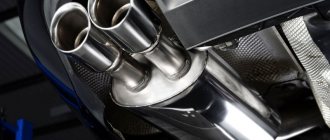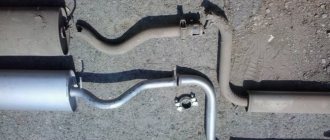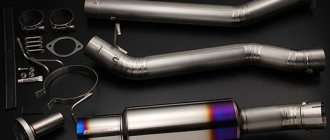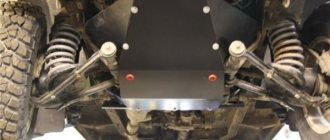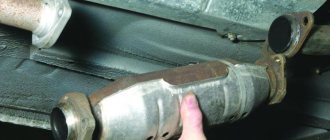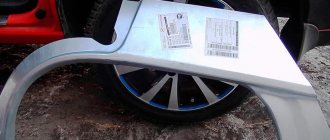The structural components of exhaust pipes on many cars fall into the category of problematic parts. They rust quickly, often burn out and break. Replacing the exhaust system is also not an option, since it can become unusable after serving for less than a year. Some car enthusiasts prefer to make a muffler with their own hands and try to use more durable consumables. What do the step-by-step instructions look like, and what will you need to complete the work?
The exhaust pipe system may seem quite simple, but this is just the first impression. In fact, it implements a number of functions, including not only noise reduction, but also reducing the toxicity of exhaust gases, their temperature and sound intensity during fuel combustion. In the muffler area, due to dispersion, the exhaust is finally deprived of temperature and speed indicators. How can you make a muffler with your own hands, and which methods should you give preference to?
What does white smoke from the exhaust pipe mean? You can find the answer to this question in the detailed material of our author.
We also recommend reading our specialist’s article, which talks about how to make a flame arrester for a car with your own hands.
There are several options that car enthusiasts use to make a muffler for their car with their own hands. The choice of a specific method depends on the exhaust system tuning option and the size of the budget you are counting on. This could be a muffler made from a powder fire extinguisher or the manufacture of a straight-through muffler.
Powder fire extinguisher muffler
Modification of a standard muffler is possible on the basis of a powder fire extinguisher whose service life has expired.
Necessary materials
Additionally, you should prepare:
- welding electrodes 1.5 - 2.5 mm;
- electric welding machine;
- compact grinder with cutting wheels for metal;
- parts of the old muffler;
- two pieces of steel pipe with an internal diameter of two inches.
Stage-by-stage execution of work
The manufacturing process is as follows.
- Prepare a pipe of a suitable size with a diameter of 30 - 52 mm. It is unlikely that you will be able to find thin-walled factory-type pipe, so just use tap pipe.
- Unscrew the cap from the fire extinguisher and get rid of the remaining powder.
- Enlarge the hole until the pipe you prepared fits snugly into it.
- A similar hole must be made on the other side of the cylinder, but it should be slightly shifted towards the wall of the fire extinguisher.
- Use a grinder to create perforations on the end sections located inside the pipes (12 - 15 cm).
- Insert the pipes into the cylinder, calculating the opposite arrangement of the perforated sections opposite each other. The ends should be inserted 60% into the balloon.
- Weld the joints on both sides of the cylinder in a circular direction. Be careful not to burn the metal of the fire extinguisher.
- Remove the fasteners from the old fire extinguisher and weld them onto the resulting homemade structure. Please note that the water pipe is heavier than the factory car pipe, so provide reinforcement for the fastening. On the other hand, the heavier the pipe, the quieter the muffler.
- To reduce noise levels and increase the service life of the structure by two years, insert a flexible corrugation into place after the exhaust manifold. The housing can be filled with glass wool to further reduce noise.
- If you are making a muffler from stainless steel, provide for the possibility of disassembling the structure. It can be partially dismountable, and you will have the opportunity to periodically clean the cavities and make repairs if necessary.
- Be sure to check the tightness and reliability of the welds by plugging one of the pipes and filling it with water upside down. There should not be even a slight leak.
- Drain the water and use a compressor to blow out the product and remove any remaining moisture.
- The design is ready for installation on a car.
We also advise you to carefully read our expert’s article, which describes in detail how the muffler resonator is designed.
You may also be interested in an article by our specialist, in which he talks about how to choose a thermal tape for a muffler.
Restoration work.
First, let's look at restoration using cold welding. Nowadays, almost every motorist has mastered this technique. The composition of this consistency quickly takes the required shape and hardens in it. At the same time, it is quite resistant to various influence factors. Today, there are two main types of sealants - liquid and flexible. Liquid sealants will also help to make bandages on the muffler. The combination of the two materials will give an improved result and give you back a quiet muffler. Flexible polymers that have a structure resembling plasticine in appearance. They attach well to metal, even with severe damage. Instructions for using sealant. First of all, you need to completely clean and degrease (you can use a handy product - gasoline) the surface. Then, we eliminate the unevenness using sandpaper.
Now, you need to prepare the composition for restoration. Flexible - first knead with your hands and stretch out the required amount. Liquid - stir until it reaches a homogeneous consistency. Apply the composition evenly to the damaged area. When using an already prepared composition, it is necessary to quickly apply it to the surface. These sealants quickly take on a solid state. After restoration, you must wait until the composition has completely hardened. If the car is used prematurely, the structure will be damaged. Depending on the material, drying time varies. Before carrying out work, carefully read the instructions for the composition.
About direct flow or PG
A direct-flow muffler (PG) is an improved alternative to a stock exhaust, which is not capable of ensuring a quick and timely release of gases from the engine system (ICE). The standard exhaust system especially suffers (chokes) after installing a sports camshaft or after boring the cylinder head cylinders (in other words, on a forced engine).
A straight-through muffler is designed to improve the exhaust system
The GHG is designed to modernize the exhaust system, which increases gas emissions. In addition, a correctly installed PG will provide an increase in internal combustion engine power by 10–15 hp. However, you need to be prepared for drastic changes: everything will need to be replaced, from the catalyst to the tip.
Types of noise-absorbing elements
Silencers in cars can be active, which is a fairly simple device, or reactive. In the first case, vibration-resistant materials that can withstand high temperatures are used for their production. Active devices are the most popular because they are easy to use. Their significant disadvantage is their rapid contamination. Silencer reactive devices consist of complex elements of resonator chambers.
As for the rear noise-absorbing chamber of the car, its structure contains many compartments that contain a special filler. It is necessary to reduce the sound of exhaust gases when the car engine is running. Modern car mufflers can use several technologies for absorbing background noise and purifying emitted gases at the same time. They can contain many different materials that provide maximum reduction in the sound of exhaust gas flows, their toxicity level and temperature.
What is required to build an ASG (direct-flow exhaust system): tuning kit
Undoubtedly, installing a PG is a tuning, a modernization. And everything you need to build such a sporty exhaust option is available in stores.
The first is the resonator. Note that the sports PG does not have partitions that prevent the escape of gases. Its entire design is aimed only at ridding the internal combustion engine of excess gases generated during fuel combustion. As a result, power increases due to increased airflow.
Interesting point. On cars equipped with a naturally aspirated internal combustion engine, installing a sports PG allows you to increase power by 10 percent of the standard power, and on turbocharged cars - by 20 percent or even more.
The second necessary element, of course, is a new direct-flow flame arrester. The universal damper is intended as an alternative to the standard catalyst when constructing a direct flow. Such an element must be made of stainless steel (there is an option of aluminized steel). The internal part of such a flame arrester has a universal design, designed to increase the power of the machine’s power unit.
The structure of the muffler in the form of a diagram gives a complete picture of it
Fastening elements and other accessories, which must include various adapters, adapters, flanges, thermal tape for the exhaust manifold, etc., are also part of the system.
And finally, the muffler pipe, made of stainless steel or aluminized. The pipe itself must have an increased diameter (usually in the range of 38–76 mm). The length of the pipe is about 1000 mm, the wall thickness is 1.5 mm.
Advantages
A car enthusiast is thinking about replacing a conventional muffler with a homemade direct-flow version due to the following reasons:
- Replacing the muffler with a supply version will help increase the car's power by several horsepower. Of course, this improvement can only be felt, as they say, by seeing the data after measurement on paper. After all, it’s almost impossible to really feel the difference of a couple of horsepower. But the feeling that the car has become a little more powerful is pushing car enthusiasts all over the world to replace the conventional factory muffler with a direct-flow muffler.
- Giving the engine a noble sound, which is characteristic of powerful versions of machine power units. It is also worth noting that using various design options you can choose the appropriate sound timbre. However, whatever one may say, if you put next to a car with a powerful engine and a simple, direct-flow muffler, the sound from it will be better, mesmerizing and penetrating deep into the body, than from a conventional installed engine. But the opportunity to do something like this pleases many car enthusiasts.
- The desire to remake the car for yourself. This desire is not caused by the desire to achieve any result, but is perceived as a system for improving the car.
A straight-through muffler will help increase the car's power.
Do-it-yourself PG from handy materials
If you can’t buy ready-made tuning kits from the store, then that’s okay. You can make a homemade muffler from handy materials. However, it is not recommended to use old, used mufflers for this, since as a result of repeated heating cycles, their metal loses its original properties.
Made of stainless steel
Stainless steel exhaust gas is the most expensive method of exhaust modernization, but also more effective. But if we also take into account the high levels of protection against aggressive environments, then this option can last for many years, and thereby save money.
To make a homemade PG from stainless steel, you need to do the following:
- take a stainless steel tube of the required diameter (the length is determined by the car model);
- put several metal brushes on it (sold in stores under the name “metal sponge”);
Metal brushes are designed in the direct-flow muffler to reduce noise
- wrap the pipe with sponges on with pieces of thin metal mesh;
Metal mesh is needed to wrap the direct-flow muffler and eliminate noise
- you need to wrap tightly so that there are no voids left (see photo);
Wrapping the muffler with a metal mesh should be done very tightly
- after wrapping, secure with wire (steel, not copper!);
- insert such a sandwich into a stainless steel pipe with a thicker diameter or wrap a stainless steel sheet over the wire;
- hammer ursa - mineral wool inside;
Ursa mineral wool gets clogged inside the muffler
- rivet the surface stainless steel sheet, first making holes in the sheet for the rivets with a drill;
- cover one of the holes of the homemade resonator with a mixture of ursa and cement (prepared in a ratio of 1 mineral wool x 3 cement).
Filling the hole with a fireproof mixture is a mandatory step in the operation of making a homemade muffler.
Step-by-step manufacturing instructions
Before you make a muffler for your car yourself, take care of two important things that are best ordered from a turner: end caps and baffles. The rest will be easy for you to handle on your own.
To make a muffler for a car and successfully install a homemade product, you need to follow the recommendations:
- Take measurements and form a jar assembly from a metal blank.
- Drill holes in the can pipes.
- Weld the pipes to the reflectors and baffles.
- Attach and secure the casing and end caps.
- Install fasteners.
- Fasten the finished part.
Making a muffler with your own hands
After installing a new exhaust device, the sound of the motor may change: become stronger or quieter, which depends on the quality of work.
How to make a straight-through muffler quieter
The PG becomes quieter as it is collected. And each craftsman does this differently, using mineral wool, metal shavings, brushes or asbestos. It is also recommended to arrange several compartments inside the homemade muffler, creating additional resonance.
The installation of direct flow in various ways involves the use of mineral wool, shavings and other fillers
A car with an exhaust louder than 96 dB does not pass inspection, does not cross the border, and does not drive around the city. This is the law. Sound today is limited even in motorsport, where it would seem there should be no restrictions or boundaries.
Having decided to suppress the GHG, you need to understand that this should in no way affect the effectiveness of the new system. None of the components of the GHG system should create resistance to exhaust gases.
Flute
The flute or silencer in the PG is a simplified design used by tuners. Its task is to “calm down” the SG, obtaining legitimate dB at the output.
Making a flute is not difficult. It will be enough to use as a muffler a piece of a perforated 20-centimeter tube with a diameter that is slightly larger than the exhaust (by 1/3). A disk or conical washer must be fixed to the pipe to act as a plug. Fastening is carried out using bolts at the air cut. The washer, in fact, creates a structure that resembles a flute.
The flute is used in PG to reduce noise
The cost of ready-made silencers in stores varies from $8 to $150. Chinese models are very cheap, but don’t expect quality from them. Original, good European-made flutes can be purchased for $100–$150.
You can assemble a flute for the PG yourself. Below is a diagram by which you can easily make such a model.
A homemade flute is easy to assemble
A homemade flute is easy to assemble:
- take a 20-centimeter steel pipe (it is recommended to use stainless steel) and a sheet of iron 1 mm thick;
- welding is carried out (preferably arc);
- Initially, a plug with holes for 8 bolts should be welded to the pipe.
It is recommended to fasten it with all 3 bolts, but you can do it with 1. It will be much faster.
Damper
A SG with a damper is a universal opportunity to simultaneously increase the power of an internal combustion engine and ensure quiet forward flow. A design of this type has been known to car enthusiasts for a long time; it is even found as standard on some BMW models.
The operation of the GHG damper is based on the following principle. When the engine operates at low speeds, gases exit through a standard, conventional muffler. At this time, the SG is closed by a damper. But as soon as the internal combustion engine reaches high speeds, the damper in the PG opens, and due to enhanced ventilation, optimal torque is produced.
The damper is controlled automatically, for example, on a BMW. But manual models are also known.
The price of a ready-made system with a damper can be high, especially for cars with automatic transmission. So, the cost of such a system, together with a titanium spider, is approximately 2-3 thousand dollars.
Analogue models, similar in capabilities to the original ones, are more moderately priced. However, a successful upgrade of this option may require the specific knowledge of an experienced minder.
Direct flow with a damper is considered the most effective option for increasing the power of an internal combustion engine
You can make a damper yourself, but it is impossible to predict the result of such an installation. It's better not to take risks.
Whatever option for manufacturing PGs is chosen, ready-made models and kits should not be excluded. In some cases, it will be much easier to buy them than to bother with pipes, a welding machine and fillers.
How else to reduce exhaust system noise
The resulting sound and additional power will likely only appeal to the owner of the new muffler and his congenial friends. For the rest, some noise reduction measures can be provided when this is critical.
Typically, either a controlled damper on the exhaust or a removable conical insert in the form of a perforated tube with an expander, also called a flute, is used.
The flute can be quickly installed or removed when it is not needed, and the damper, reminiscent of the throttle of an injection engine, can be controlled remotely, if desired, even from the driver’s seat.
In more complex exhaust systems, even switching flaps are used, when the flow can be directed either to a standard muffler or to a sports direct-flow muffler.
Muffler design for VAZ 2101/2107/2109/2110/2015
Despite the fact that the principle of operation of all VAZ muffler classics and later models is the same, they still have design distinctive features.
For example, consider the muffler design on a VAZ 2101.
The product has three cameras, the general structure is presented below:
- Upper half-body;
- Thermal insulation;
- casing;
- Partitions of the right and left chambers;
- Inlet pipe;
- Front partition;
- Perforated exhaust pipe;
- Perforated pipe internal;
- Perforated intake pipe casing;
- Rear partition;
- Semi-hull lower;
- Exhaust pipe;
- Front exhaust pipe;
- Main muffler;
- Suspension strap;
- Pillow suspension;
- Grazing pipe.
Muffler design of late models using the example of a VAZ 2110.
- Reception pipe;
- Bracket;
- Clamps;
- Resonator;
- Suspension cushions;
- Main muffler;
- Exhaust pipe;
- Perforated rear resonator tube;
- Posterior partition;
- Front partition;
- Perforated front resonator tube;
- Frame;
- Front perforated pipe;
- Inlet pipe;
- Outlet pipe;
- Frame;
- Posterior partition;
- Middle partition;
- Rear perforated pipe;
- Front partition.
